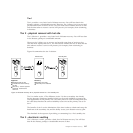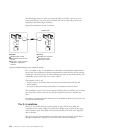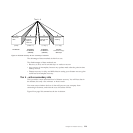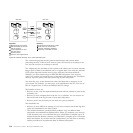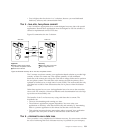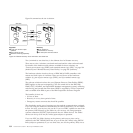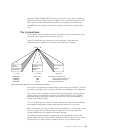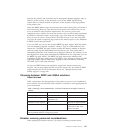v IMS write-ahead data set (WADS) and IMS online log data set (OLDS)
v ACBLIB for IMS
v Boot-strap data set (BSDS), the catalog and the directory for DB2
v DB2 logs
v Any essential non-database volumes
CICS applications can use non-DASD storage for processing data. If your
application depends on this type of data, be aware that PPRC and XRC do not
handle it.
For more information on PPRC and XRC, see Planning for IBM Remote Copy,
SG24-2595-00, and DFSMS/MVS Remote Copy Administrator's Guide and Reference.
PPRC or XRC?
You need to choose between PPRC and XRC for transmitting data to your backup
site. This topic compares the two methods to help you make your choice.
Choose PPRC as your remote copy facility if you:
v Require data currency at the secondary site
v Have your recovery site within ESCON distance
v Can accept some performance degradation
v Have a duplicate DASD configuration available at the remote site
The synchronous nature of PPRC ensures that, if you have a disaster at your main
site, you lose only inflight transactions. The committed data recorded at the remote
site is the same as that at the primary site.
Use PPRC for high value transactions
Consider PPRC if you deal with high value transactions, and data integrity in a
disaster is more important to you than day-to-day performance. PPRC is more
likely to be the solution for you if you characterize your business as being low
volume, high value transactions; for example, a system supporting payments of
thousands, or even millions, of dollars.
Choose XRC as your remote copy facility if you:
v Can accept that your data at the secondary site will be a few seconds behind the
primary
v Have your secondary site outside ESCON distance
v Require high performance at the primary site
The asynchronous nature of XRC means that the remote site may have no
knowledge of transactions that ran at the primary site, or does not know that they
completed successfully. XRC ensures that the data recorded at the remote site is
consistent (that is, it looks like a snapshot of the data at the primary site, but the
snapshot may be several seconds old).
Use XRC for high volume transactions
Consider XRC if you deal with low value transactions, and data integrity in a
disaster is less important to you than day-to-day performance. XRC is more likely
to be the solution for you if you characterize your business as being high volume,
low value transactions; for example, a system supporting a network of ATMs,
Chapter 19. Disaster recovery 235



